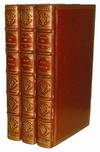![New Magnetic Phenomena in liquid He3 below 3 mK (Osheroff) WITH Interpretation of Recent Results on He3 below 3 mK: A New Liquid Phase? (Leggett) in Physical Review Letters, Volume 29, 1972, pp. 920-923; pp. 1227-1230 [NOBEL PRIZE WINNING DISCOVERY OF SUPERFLUIDITY IN HELIUM 3]](https://d3525k1ryd2155.cloudfront.net/h/028/265/873265028.0.m.jpg)
New Magnetic Phenomena in liquid He3 below 3 mK (Osheroff) WITH Interpretation of Recent Results on He3 below 3 mK: A New Liquid Phase? (Leggett) in Physical Review Letters, Volume 29, 1972, pp. 920-923; pp. 1227-1230 [NOBEL PRIZE WINNING DISCOVERY OF SUPERFLUIDITY IN HELIUM 3]
by Osheroff, D. D.; W. J. Gully; R. C. Richardson; D. M. Lee WITH A. J. Leggett
- Used
- Hardcover
- first
- Condition
- See description
- Seller
-
West Branch, Iowa, United States
Payment Methods Accepted
About This Item
Rome: American Institute of Physics, 1972. 1st Edition. BOUND FIRST EDITION OF OSHEROFF, RICHARDSON, & LEE'S NOBEL PRIZE WINNING DISCOVERY OF SUPERFLUIDITY IN HELIUM 3. Superfluidity is one "of the greatest physics discoveries in the first half of the 20th century" (Donnelly, The Discovery of Superfluidity, Physics Today, July 1995, 30). The discovery of superfluidity in helium 3 was very unexpected - so unexpected that the paper submitted by Osheroff et al. was initially rejected by Physical Review Letters; it simply wasn't believed. This volume also contains Leggett's very significant paper on the superfluidity of helium-3 (see below). Leggett's paper was a "particularly importation contribution...in the interpretation of the discovery [by Osheroff et al]" (Nobel Prize Portal). Leggett also received the Nobel Prize for his pioneering work on superfluids. "Superfluidity is a condition observed in liquid helium when it is chilled very close to absolute zero (about minus 459.67 degrees Fahrenheit" (Browne, NYT, 10 October, 1996). Ordinary liquid helium 4 was discovered as early as the 1930s and has since become an important scientific tool. "But a rare isotope, or form, of helium -- helium-3 -- proved to be much more difficult to convert to a superfluid state, despite theoretical predictions that the substance could exist" (ibid). Others had tried. Working in their Cornell University lab in 1971, Osheroff and his team were actually studying "a phase transition to a kind of magnetic order in frozen helium-3 ice. "Osheroff noticed indications of pressure changes within the helium-3. He made careful note of the changes, believing that they indicated the helium-3 had undergone the transition to a superfluid. The three scientists soon learned that Osheroff was correct, but their results were so unexpected that the scientific community did not accept them until other teams reproduced the results over the next year. "A liquid in the superfluid state does not behave according to the same laws of physics that normal fluids, such as water, obey. Instead, superfluids are subject to the complex statistical rules of quantum mechanics, the branch of physics that predicts how atomic and subatomic particles behave. Superfluids are important to physicists because they offer a macroscopic, or relatively large, system in which scientists can study quantum effects." (Agarwal, Nobel Prize Winners in Physics, 290). "Superfluid helium loses the viscosity associated with ordinary fluids and flows without resistance. It can climb the walls of containers and flow down the outside, among many other strange tricks" - like its magnetic properties (Browne, NYT, 10 October, 1996). "The new quantum liquid helium-3 has very special characteristics. One thing these show is that the quantum laws of microphysics sometimes directly govern the behaviour of macroscopic bodies also" (Nobel Prize Portal). For their discovery of superfluidity in helium-3, Osheroff, Richardson, and Lee were awarded the Nobel Prize in 1996. The transition between helium-3 as an ordinary substance and liquid helium-3 in its superfluid state may offer insights into cosmic mysteries, the Nobel committee said (Nobel Prize Portal). ALSO INCLUDED (pp. 1227-1230): Anthony James Leggett's Nobel Prize winning paper on the superfluidity of Helium-3, "one of the holy grails of condensed matter physics" (Bishop, Recent Progress in Many-Body Theories, 4). Widely regarded as a world leader in low-temperature physics, in this paper Leggett "explains how atoms interact with one another in a superfluid"; specifically, he details "the anomalous superfluidity of helium-3...using the principles of quantum mechanics (Nndb). Leggett's work in this paper greatly advanced our understanding of how matter transitions from one phase to another (Rezende, Chronology of Science, 396). CONDITION & DETAILS: Rome, New York: American Institute of Physics. 4to (10.5 x 8 inches; 263 x 200mm). Entire volume, 1214 pp. Ex-libris with some markings (pictorial plate on paste down, however no spine markings whatsoever). Illustration: In-text figures throughout. Exterior: Bound in red buckram with a gilt-lettered spine. Tight, solid. Interior: Bright and very clean throughout. Near fine condition.
Reviews
(Log in or Create an Account first!)
Details
- Bookseller
- Atticus Rare Books
(US)
- Bookseller's Inventory #
- 681
- Title
- New Magnetic Phenomena in liquid He3 below 3 mK (Osheroff) WITH Interpretation of Recent Results on He3 below 3 mK: A New Liquid Phase? (Leggett) in Physical Review Letters, Volume 29, 1972, pp. 920-923; pp. 1227-1230 [NOBEL PRIZE WINNING DISCOVERY OF SUPERFLUIDITY IN HELIUM 3]
- Author
- Osheroff, D. D.; W. J. Gully; R. C. Richardson; D. M. Lee WITH A. J. Leggett
- Book Condition
- Used
- Quantity Available
- 1
- Edition
- 1st Edition
- Binding
- Hardcover
- Publisher
- American Institute of Physics
- Place of Publication
- Rome
- Date Published
- 1972
Terms of Sale
Atticus Rare Books
30 day return guarantee, with full refund including shipping costs for up to 30 days after delivery if an item arrives misdescribed or damaged.
About the Seller
Atticus Rare Books
Biblio member since 2010
West Branch, Iowa
About Atticus Rare Books
We specialize in rare and unusual antiquarian books in the sciences and the history of science. Additionally, we specialize in 20th century physics, mathematics, and astronomy.
Glossary
Some terminology that may be used in this description includes:
- New
- A new book is a book previously not circulated to a buyer. Although a new book is typically free of any faults or defects, "new"...
- Tight
- Used to mean that the binding of a book has not been overly loosened by frequent use.
- Plate
- Full page illustration or photograph. Plates are printed separately from the text of the book, and bound in at production. I.e.,...
- Spine
- The outer portion of a book which covers the actual binding. The spine usually faces outward when a book is placed on a shelf....
- First Edition
- In book collecting, the first edition is the earliest published form of a book. A book may have more than one first edition in...
- Buckram
- A plain weave fabric normally made from cotton or linen which is stiffened with starch or other chemicals to cover the book...
- Fine
- A book in fine condition exhibits no flaws. A fine condition book closely approaches As New condition, but may lack the...

